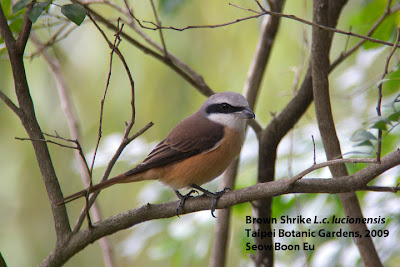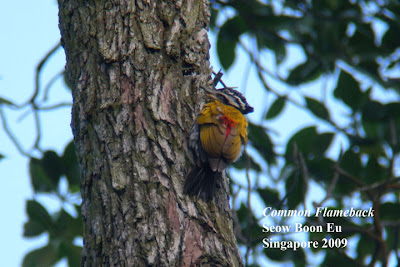This year's Lunar New Year is on 14th of February, will be celebrated by more than a quarter of the world's population. The Lunar New Year is an official and major holiday in the East Asia region, from as far north in the Heilongjiang in China and Mongolia to the south of the island city of Singapore, and from the east of Korean Peninsula to Xinjiang and Tibet of China.
If you are interested to understand more about the Chinese New Year and the Chinese lunisolar calender, I strongly recommend a paper "The Mathematics of the Chinese Calender" by Helmer Alasksen, a professor from the National University of Singapore (NUS). This calender has major cultural and social influence to Chinese, Mongolian, Manchurian, Korean, Vietnamese and Okinawan (Ryukyuan), and minor influence to Japanese (Japan adopted Gregorian calender after the Meiji restoration).
The animal zodiac for this year's lunar new year is the Tiger. Thus, I would like to select a bird to represent the year of Tiger - the Tiger Shrike (Lanius tigrinus), (虎纹伯勞). Tiger Shrike is a monotypic species, it is a winter migrant in peninsular Malaysia and Singapore.
The majority of shrikes are large-headed, hook-beaked and sharp-clawed. Only raptors, owls and shrikes are sharp-clawed birds. The sharp claws are their lethal weapon when preying. Occasionally, I classify shrike as a "raptor of passerine" (haha...) due to their sharp claws and their hunting behaviour which are closely similar to the raptor, especially the falconet. Following are my observation of Tiger Shrike and other species of Shrikes.
A juvenile Tiger Shrike eating wasp:
Shrikes are principally birds of open country, prefer to perch on the prominent lookouts such as posts, stick or tall bushes to search for their preys, which ranges from small birds and mammals, to insects, lizards and frogs. I learned they also know how to use thorn or bamboo branch (tools) to tear the meat.
Check out this LINK to learn more on how shrike preying on small bird.
There are 30 species of shrikes widespread across Europe, Asia and Africa, only two species in the North America. There are three main species of shrikes occur in Peninsular Malaysia and all are the winter visitors. The species include the Tiger Shrike, Brown Shrike and Long-tailed Shrike.
Brown Shrikes, Lanius cristatus (红尾伯勞) are the most widespread species, they breed in the northern Asia and winter in South Asia and South-east Asia. It is the most common shrike in Penang.
There are four subspecies of Brown Shrikes, namely superciliosus, cristatus, lucionensis and confusus. L.c. superciliosus has warm rufous-brown upperparts, broad mask from forehead to ear-coverts bordered by broad white supercilia joining on the white forehead. It is a common shrike in Japan, but I have yet to see any of this subspecies.
L.c. cristatus is like a pale superciliosus with colder, sandy-brown crown, white supercilia has less contrast, forehead narrower. Here are the cristatus subspecies I spotted in Taiwan.
L.c. lucionensis subspecies (灰头红尾伯勞), has ash-grey on forehead with variable white above black mask, crown and nape grey, mantle greyish-brown. I spotted this subspecies in Taipei Botanic Gardens, Taiwan, it was my subspecies lifer with distinguishable grey head.
L.c. confusus subspecies resembles lucionensis, but head browner and broader white forehead.
Check out this LINK to learn more about the distribution of the Brown Shrikes.
Long-tailed Shrike, Lanius schach (长尾伯勞) is the rarest shrike in Malaysia, it has many subspecies, which include the longicaudatus, schach, bentet, formosae, tricolor and etc.
The bentet subspecies is the common Long-tailed Shrike in this region, it has grey scapular with whitish outer edge, I spotted this subspecies in KLT, Ipoh, was my subspecies lifer.
The formosae subspecies (棕背伯勞) has thicker rufous scapular, whereas the schach subspecies has thinner rufous on the scapular as compared to formosae. I spotted the formosae subspecies in Yilan, Taiwan, it was my subspecies lifer.

There are other subspecies of Long-tailed Shrikes, longicaudatus and tricolor occur in South Asia and Northern part of mainland South-east Asia, nastutus in Philippines and East Sabah. I wish one day I will be able to see them, including the adult Tiger Shrike.
Tips to identify and to differentiate the Brown, Tiger and Long-tailed Shrikes:
1. Brown Shrikes have rufous-brown tail, wing is longer than tail.
2. Tiger Shrikes, mantle, wings, rump and tail rufous-brown/chestnut, mostly with distinct black scaling. Mostly with distinct slightly over-sized bill.
3. Long-tailed Shrikes, with black, grey, white and rufous plumage, long black graduated tail, and rounded tip.
I hope the reader will learn something about shrikes and its subspecies, hope that more birders will pay more attention to shrikes, especially the multi-subspecies of Brown Shrike and Long-tailed Shrike. Hope one day, we will have more information about the type of subspecies that occur in Malaysia and Singapore. Kindly feedback to me if you find any mistake in the subspecies identification.
Last but not least, please view this video clip:
Don't let this be the last year of the Tiger, join TX2 to save the Malayan Tiger.
Happy Lunar New Year, 新年快乐。
** I would like to thank Connie Khoo for the Long-tailed Shrike and Tiger Shrike in KLT, Ipoh, both were my lifers. Thanks to Eu Meng as a birding companion for my second Tiger Shrike in SBG.
































